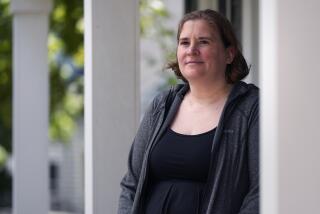L.A. Unified dishes out health benefits
A groundbreaking motion before the city’s Board of Education this week was ostensibly about how best to help students get a healthy, tasty school lunch with enough time to eat it.
But the more fundamental issue was a union campaign -- now successful -- seeking health benefits for part-time cafeteria workers in the Los Angeles Unified School District. The union, Local 99, scored a major victory courtesy of officials elected with its help and that of another key ally, Mayor Antonio Villaraigosa.
After a two-hour debate this week, the board voted to extend the schedule of part-time cafeteria workers to four hours a day. That change immediately qualified 2,352 workers for health benefits under existing labor agreements. About 2,390 food-service-related workers already had benefits, the district said.
The school district puts the annual new cost at $35.5 million; the union estimate is about $28 million. Either way, the district has identified no money to pay for the benefits.
The move to extend benefits could not have happened faster for members of the new board majority. They introduced the motion at their first regular meeting in July and passed it at the first opportunity -- this week’s meeting. The previous board had opted for less expensive staff recommendations that focused not on health coverage but on the most efficient means to improve service, which all sides agree is lacking.
That approach, however, became out of date July 1 when Richard Vladovic replaced Mike Lansing and Yolie Flores Aguilar replaced David Tokofsky. The campaigns of both Vladovic and Flores Aguilar benefited from political action committees and unions affiliated with the Service Employees International Union, of which Local 99 is a part.
Vladovic’s campaign received $68,460 from an SEIU-affiliated political action committee and $49,547 from that of the L.A. County Federation of Labor. Villaraigosa’s overall campaign to elect a new school board majority received $100,000 from SEIU Local 434B, which represents home healthcare workers.
Vladovic and Flores Aguilar cosponsored the board motion along with new board President Monica Garcia, a Villaraigosa and labor ally.
“We can be leaders in national healthcare,” including pressing for universal coverage, Garcia said. “Health benefits for cafeteria workers will help this district gain its own health.”
Proponents characterized the extension of benefits as a social justice issue, pointing out that district managers had created difficult, staggered shifts to keep cafeteria workers under four hours a day -- the threshold for benefits. The result, they said, was hard-to-fill jobs and poor service, let alone a less healthy workforce.
Opponents insisted that the school system shouldn’t add to its health-cost burden at the price of cutting into resources for students. L.A. Unified, they said, is the wrong forum in which to address a nationwide health insurance crisis.
To blunt this criticism, the union’s campaign talked foremost about students such as Josh Ruiz, 16, a junior at Venice High. When the lunch bell rings he must dash into line, he said, or choose between having five minutes to eat or being late to class.
At a media event, the union also featured Kathleen Hamm, a single mother whose asthmatic son can’t run the lunch race. So he doesn’t eat, she said, until after the bus ride home.
That theme was reinforced in a video presentation at Tuesday’s board meeting that featured students who’ve given up on trying to get food during lunchtime.
The board resolution, in fact, doesn’t mention health benefits anywhere in its 317 words. Instead, it lauds food services’ mission to “nourish children to achieve excellence.” It also praises district nutritional guidelines, notes district policy of giving each student at least 20 minutes to eat and bemoans low student patronage.
The solution?
“That effective Sept. 1, 2007, the district increases the hours of all cafeteria employees to at least four hours a day and at least 800 hours a year to enable the last child in line to have 20 minutes to eat their lunch.”
But the motion was more directly about the plight of workers such as Gama Andrade and Catherine Zamarripa.
Andrade, 29, a six-year district employee, works 15 hours a week at Murchison Elementary.
“If I get sick, I have to tough it out,” he said.
Zamarripa, 49, has no insurance after 10 years of service to the district. She works 17 hours a week at University High in West Los Angeles.
“I have bad teeth, and that leads to ear and throat infections so I can’t go to work,” she said. If need be, she goes to a free or low-cost health clinic, “but you’ve got to miss a day of work.”
Both have scrambled for healthcare alternatives. Andrade’s children get insurance through their mother, with whom he no longer lives.
Officials said about 44% of district part-timers get insurance through other means, including Zamarripa, whose husband took a part-time job at a video store for that reason. But it’s limited. Instead of fixing her teeth, she says, she has just enough money to remove the one or two worst ones each year.
The slight extension of the workday, typically by 30 or 60 minutes, makes a marked difference for these workers but bears little relation to staff and consultant recommendations developed over the last year. Those called for improved facility design, longer lunch hours and more multiple lunch periods, as well as better, more nutritious food. More staff hours were part of the plan, but only 269 more workers would have qualified for benefits as a result.
The cafeteria fund already is in the red, but proponents hope to recoup funds by encouraging more students to eat school food -- only 35% of secondary school students currently partake. District staff said improved participation would not make the difference.
Board President Garcia said it would be the job of Supt. David L. Brewer to make the longer work hours lead to improved food service. He’ll also have to find the money, prompting board member Julie Korenstein to ask whether he knew where to find it in the district’s $6.2-billion budget.
Brewer resisted being drawn into the discussion, but when pressed repeatedly, said: “Based on what I know about the budget, we cannot afford it. What else can I say?”
Flores Aguilar jumped in reassuringly: “I’m confident you’re going to find a lot of fat, bureaucracy.”
That comment nearly put board member Marlene Canter, who has led board efforts to ban junk food, into a fury.
“I agree with everything you said about more food and healthy eating,” she told Garcia at one point. “We do not need to increase the hours. That will not get children fed. . . . Social justice doesn’t always equate to affordability.”
Extending health benefits to all 18,700 part-time district employees would cost more than $250 million, district officials said.
The only no votes were from Canter and Tamar Galatzan. Even Korenstein, who called the measure “ludicrous” and “fiscally irresponsible,” wilted under a full-court press that included Maria Elena Durazo, head of the Los Angeles County Federation of Labor, and Korenstein’s longtime ally, United Teachers Los Angeles.
At a post-vote rally, board members took turns celebrating with workers.
“Whether there’s money or not,” said board member Marguerite Poindexter LaMotte, “it’s time we moved.”
“I’m just overwhelmed with joy,” said cafeteria worker Andrade.
“Finally, I have some security for myself and for my kids.”
More to Read
Sign up for Essential California
The most important California stories and recommendations in your inbox every morning.
You may occasionally receive promotional content from the Los Angeles Times.











